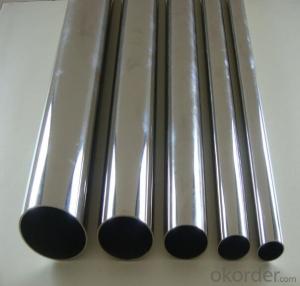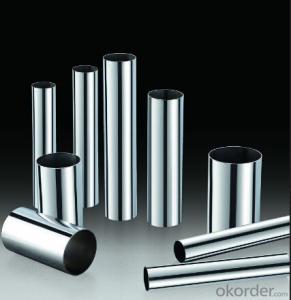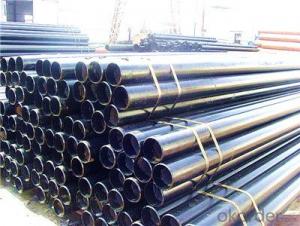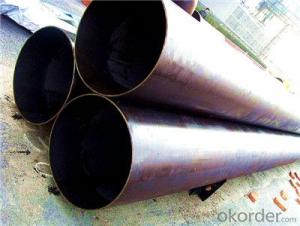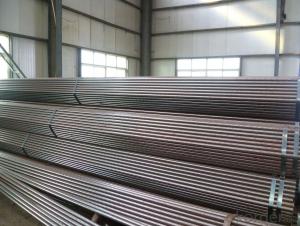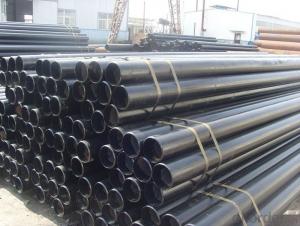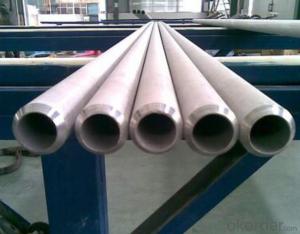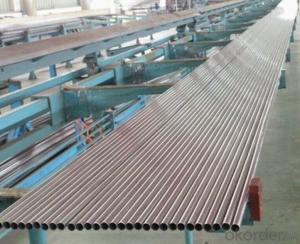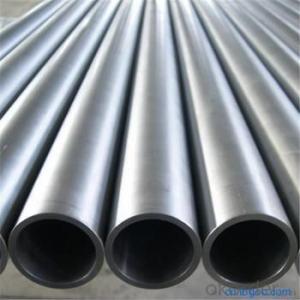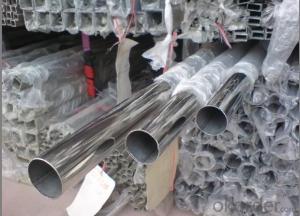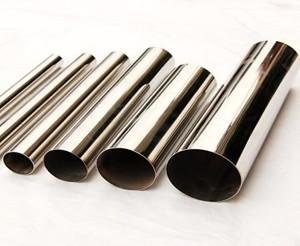Stainless Seamless Round Steel Tube With Good Price
- Loading Port:
- China main port
- Payment Terms:
- TT or LC
- Min Order Qty:
- 100 m.t.
- Supply Capability:
- 10000 m.t./month
OKorder Service Pledge
OKorder Financial Service
You Might Also Like
1、Structure of Seamless Pipe ASTM A106/53:
Seamless pipe is formed by drawing a solid billet over a piercing rod to create the hollow shell, and they are perceived to be stronger and more reliable. Historically seamless pipe was regarded as withstanding pressure better than other types.
2、Main Features of the Seamless Pipe ASTM A106/53:
• Reasonable price
• High manufacturing accuracy
• High strength
• Small inertia resistance
• Strong heat dissipation ability
• Good visual effect
3、Seamless Pipe ASTM A106/53 Specification:
Standard | GB, DIN, ASTM ASTM A106-2006, ASTM A53-2007 |
Grade | 10#-45#, 16Mn 10#, 20#, 45#, 16Mn |
Thickness | 8 - 33 mm |
Section Shape | Round |
Outer Diameter | 133 - 219 mm |
Place of Origin | Shandong, China (Mainland) |
Secondary Or Not | Non-secondary |
Application | Hydraulic Pipe |
Technique | Cold Drawn |
Certification | API |
Surface Treatment | factory state or painted black |
Special Pipe | API Pipe |
Alloy Or Not | Non-alloy |
Length | 5-12M |
Outer Diameter | 21.3-610mm |
Grade | 20#, 45#, Q345, API J55, API K55, API L80, API N80, API P110, A53B |
Standard | ASME, ASTM |
4、FAQ of Seamless Pipe ASTM A106/53:
①How is the quality of your products?
Our products are manufactured strictly according to national and internaional standard, and we take a test on every pipe before delivered out. If you want see our quality certifications and all kinds of testing report, please just ask us for it.
Guaranteed: If products’ quality don’t accord to discription as we give or the promise before you place order, we promise 100% refund.
②How about price?
Yes, we are factory and be able to give you lowest price below market one, and we have a policy that “ for saving time and absolutely honest business attitude, we quote as lowest as possible for any customer, and discount can be given according to quantity”,if you like bargain and factory price is not low enough as you think, just don’t waste your time.Please trust the quotation we would give you, it is professional one.
③Why should you chose us?
Chose happens because of quality, then price, We can give you both.Additionally, we can also offer professional products inquiry, products knowledge train(for agents), smooth goods delivery, exellent customer solution proposals.Our service formula: good quality+good price+good service=customer’s trust
SGS test is available, customer inspection before shipping is welcome, third party inspection is no problem.
Any question, pls feel free to contact us !
5、Seamless Pipe ASTM A106/53 Images:
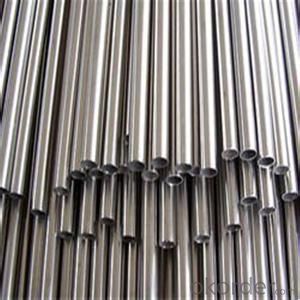
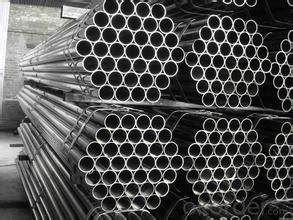
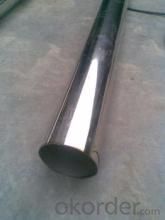
- Q: Are stainless steel pipes resistant to corrosion?
- Stainless steel pipes possess a remarkable resistance against corrosion, owing to the inclusion of chromium in their composition. This results in the formation of a passive layer on the pipe's surface, acting as a shield against corrosive elements. By doing so, it effectively prevents the metal beneath from encountering any detrimental substances. Comparatively, stainless steel contains a chromium content of at least 10.5%, surpassing other steel types, thus augmenting its ability to ward off corrosion. Given this exceptional quality, stainless steel pipes find extensive usage in industries such as construction, oil and gas, and automotive. Such application is vital to ensure the pipes' durability and integrity over time.
- Q: Are stainless steel pipes suitable for underground drainage systems?
- Indeed, underground drainage systems can utilize stainless steel pipes as they possess the necessary qualities. Stainless steel exhibits remarkable resistance against corrosion, rendering it an impeccable substance for scenarios involving exposure to moisture and other corrosive elements. Moreover, stainless steel pipes boast an extensive lifespan and necessitate minimal upkeep, thereby proving to be an economically sound choice for underground drainage systems. Furthermore, they possess the capability to endure high pressure and temperature fluctuations, thereby ensuring the longevity and dependability of the drainage system. All in all, stainless steel pipes deliver exceptional performance and represent a trustworthy option for underground drainage systems.
- Q: How do you protect stainless steel pipes from external damage?
- To protect stainless steel pipes from external damage, there are several measures you can take: 1. Apply a protective coating: Using a protective coating such as paint or epoxy can help shield the stainless steel pipes from moisture, chemicals, and physical damage. The coating should be selected based on the specific environment and potential risks to ensure maximum protection. 2. Install pipe supports: Properly installing pipe supports can prevent excessive movement and vibration, which can lead to damage over time. Using brackets, clamps, or hangers to secure the pipes in place will minimize the risk of external impacts causing harm. 3. Implement corrosion prevention measures: Stainless steel pipes are resistant to corrosion, but in certain environments, they can still be susceptible to damage. Regularly inspect the pipes for signs of corrosion and promptly address any issues. Applying corrosion inhibitors or using cathodic protection techniques can also help safeguard the pipes from external damage. 4. Use protective guards or covers: In areas where the pipes are exposed to potential impact or physical damage, installing protective guards or covers can provide an additional layer of protection. These guards can be made of materials such as plastic or rubber and can be easily installed or removed as needed. 5. Implement proper handling and storage procedures: During transportation or storage, it is essential to handle stainless steel pipes with care. Avoid dropping or dragging them and ensure they are stored in a clean, dry, and well-ventilated area to prevent moisture buildup and potential damage. By following these measures, you can effectively protect stainless steel pipes from external damage, prolonging their lifespan and ensuring their functionality.
- Q: How are stainless steel pipes graded?
- Stainless steel pipes are graded based on a variety of factors to determine their quality and suitability for different applications. The grading system of stainless steel pipes typically takes into account factors such as their chemical composition, mechanical properties, and manufacturing process. One of the key aspects of grading stainless steel pipes is their chemical composition, which refers to the specific elements and their quantities present in the alloy. The most common elements found in stainless steel pipes include chromium, nickel, molybdenum, and carbon. The percentage of these elements affects the corrosion resistance, strength, and durability of the pipes. Different grades of stainless steel pipes have varying compositions, allowing them to be used in diverse environments and applications. Another important factor in grading stainless steel pipes is their mechanical properties, such as tensile strength, yield strength, and elongation. These properties determine the structural integrity and performance of the pipes under different conditions. Higher grades of stainless steel pipes generally possess superior mechanical properties, making them suitable for high-pressure and high-temperature applications. The manufacturing process also plays a crucial role in grading stainless steel pipes. The pipes undergo various processes, including hot rolling, cold rolling, and heat treatment, to shape them and enhance their properties. The quality of the manufacturing process greatly affects the final grade of the stainless steel pipes. Pipes that are produced using advanced techniques and stringent quality control measures are typically assigned higher grades. In summary, stainless steel pipes are graded based on their chemical composition, mechanical properties, and manufacturing process. These grading criteria ensure that different grades of stainless steel pipes are available to meet the specific requirements of different industries and applications.
- Q: What is the weight of stainless steel pipes?
- The weight of stainless steel pipes can vary depending on the size, thickness, and length of the pipes. It is important to consider these factors in order to determine the exact weight of stainless steel pipes.
- Q: Can stainless steel pipes be used for nuclear applications?
- Yes, stainless steel pipes can be used for nuclear applications. Stainless steel is known for its corrosion resistance and high strength, making it suitable for nuclear power plants where it is crucial to prevent leaks and ensure long-term durability. Additionally, stainless steel is resistant to radiation damage, making it a reliable choice for transporting radioactive materials in a nuclear facility.
- Q: Can stainless steel pipes be used in the food industry?
- Yes, stainless steel pipes can be used in the food industry. Stainless steel is a highly durable and corrosion-resistant material, making it suitable for various applications in the food processing and handling sector. It is commonly used for transporting liquids, gases, and solids, ensuring the integrity and safety of food products. Stainless steel pipes also maintain the hygiene standards required in the food industry, as they are easy to clean and resistant to bacterial growth.
- Q: Are stainless steel pipes suitable for underground installations?
- Yes, stainless steel pipes are suitable for underground installations. Stainless steel is highly resistant to corrosion and is known for its durability and strength. It can withstand harsh underground conditions, including moisture, soil movement, and chemical exposure. Stainless steel pipes are also immune to rust and do not require protective coatings, making them ideal for long-term underground use. Additionally, stainless steel pipes have a long lifespan and require minimal maintenance, further enhancing their suitability for underground installations.
- Q: Can magnets attract stainless steel tubes?
- Stainless steel is becoming more and more popular because of its beautiful appearance, corrosion resistance and not easy to damage. More and more pots, city sculpture, architecture, decoration room etc. the use of stainless steel, stainless steel on discrimination but people do not know, some customers buy stainless steel kitchenware, stainless steel utensils with magnets in to try to try. It is stainless steel that attracts the magnet, but stainless steel can not be sucked. It seems that there is a misunderstanding about stainless steel.
- Q: Can stainless steel pipes be painted or coated?
- Indeed, it is possible to paint or coat stainless steel pipes. However, it is vital to opt for a suitable paint or coating specifically formulated for stainless steel surfaces. This is because stainless steel possesses a smooth and non-porous surface, which can pose a challenge for proper adherence of paint or coatings. Moreover, stainless steel pipes may encounter harsh environmental conditions, such as elevated temperatures or corrosive substances, thus necessitating the use of a paint or coating that is resistant to these elements. By selecting the appropriate paint or coating and employing correct surface preparation techniques, one can effectively enhance the appearance of stainless steel pipes or provide them with added protection against corrosion.
Send your message to us
Stainless Seamless Round Steel Tube With Good Price
- Loading Port:
- China main port
- Payment Terms:
- TT or LC
- Min Order Qty:
- 100 m.t.
- Supply Capability:
- 10000 m.t./month
OKorder Service Pledge
OKorder Financial Service
Similar products
Hot products
Hot Searches
Related keywords
